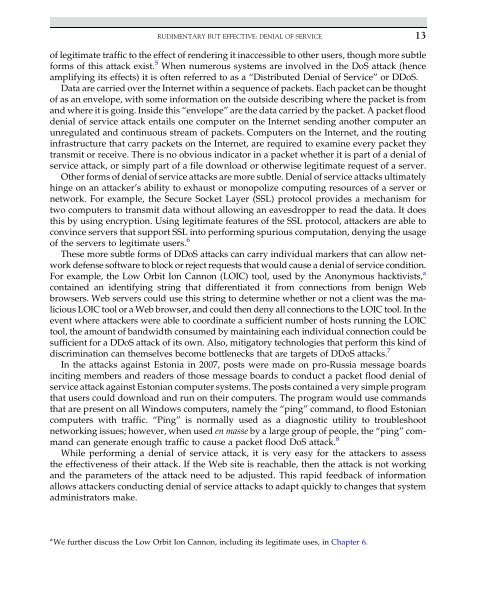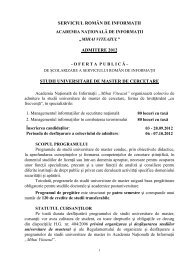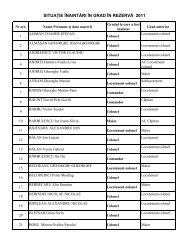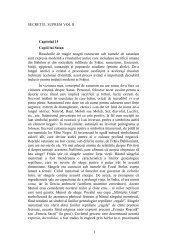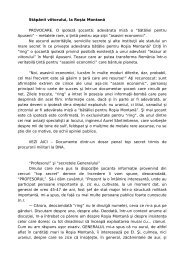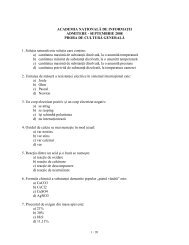Introduction to Cyber-Warfare - Proiect SEMPER FIDELIS
Introduction to Cyber-Warfare - Proiect SEMPER FIDELIS
Introduction to Cyber-Warfare - Proiect SEMPER FIDELIS
You also want an ePaper? Increase the reach of your titles
YUMPU automatically turns print PDFs into web optimized ePapers that Google loves.
RUDIMENTARY BUT EFFECTIVE: DENIAL OF SERVICE13of legitimate traffic <strong>to</strong> the effect of rendering it inaccessible <strong>to</strong> other users, though more subtleforms of this attack exist. 5 When numerous systems are involved in the DoS attack (henceamplifying its effects) it is often referred <strong>to</strong> as a “Distributed Denial of Service” or DDoS.Data are carried over the Internet within a sequence of packets. Each packet can be though<strong>to</strong>f as an envelope, with some information on the outside describing where the packet is fromand where it is going. Inside this “envelope” are the data carried by the packet. A packet flooddenial of service attack entails one computer on the Internet sending another computer anunregulated and continuous stream of packets. Computers on the Internet, and the routinginfrastructure that carry packets on the Internet, are required <strong>to</strong> examine every packet theytransmit or receive. There is no obvious indica<strong>to</strong>r in a packet whether it is part of a denial ofservice attack, or simply part of a file download or otherwise legitimate request of a server.Other forms of denial of service attacks are more subtle. Denial of service attacks ultimatelyhinge on an attacker’s ability <strong>to</strong> exhaust or monopolize computing resources of a server ornetwork. For example, the Secure Socket Layer (SSL) pro<strong>to</strong>col provides a mechanism fortwo computers <strong>to</strong> transmit data without allowing an eavesdropper <strong>to</strong> read the data. It doesthis by using encryption. Using legitimate features of the SSL pro<strong>to</strong>col, attackers are able <strong>to</strong>convince servers that support SSL in<strong>to</strong> performing spurious computation, denying the usageof the servers <strong>to</strong> legitimate users. 6These more subtle forms of DDoS attacks can carry individual markers that can allow networkdefense software <strong>to</strong> block or reject requests that would cause a denial of service condition.For example, the Low Orbit Ion Cannon (LOIC) <strong>to</strong>ol, used by the Anonymous hacktivists, acontained an identifying string that differentiated it from connections from benign Webbrowsers. Web servers could use this string <strong>to</strong> determine whether or not a client was the maliciousLOIC <strong>to</strong>ol or a Web browser, and could then deny all connections <strong>to</strong> the LOIC <strong>to</strong>ol. In theevent where attackers were able <strong>to</strong> coordinate a sufficient number of hosts running the LOIC<strong>to</strong>ol, the amount of bandwidth consumed by maintaining each individual connection could besufficient for a DDoS attack of its own. Also, mitiga<strong>to</strong>ry technologies that perform this kind ofdiscrimination can themselves become bottlenecks that are targets of DDoS attacks. 7In the attacks against Es<strong>to</strong>nia in 2007, posts were made on pro-Russia message boardsinciting members and readers of those message boards <strong>to</strong> conduct a packet flood denial ofservice attack against Es<strong>to</strong>nian computer systems. The posts contained a very simple programthat users could download and run on their computers. The program would use commandsthat are present on all Windows computers, namely the “ping” command, <strong>to</strong> flood Es<strong>to</strong>niancomputers with traffic. “Ping” is normally used as a diagnostic utility <strong>to</strong> troubleshootnetworking issues; however, when used en masse by a large group of people, the “ping” commandcan generate enough traffic <strong>to</strong> cause a packet flood DoS attack. 8While performing a denial of service attack, it is very easy for the attackers <strong>to</strong> assessthe effectiveness of their attack. If the Web site is reachable, then the attack is not workingand the parameters of the attack need <strong>to</strong> be adjusted. This rapid feedback of informationallows attackers conducting denial of service attacks <strong>to</strong> adapt quickly <strong>to</strong> changes that systemadministra<strong>to</strong>rs make.a We further discuss the Low Orbit Ion Cannon, including its legitimate uses, in Chapter 6.


